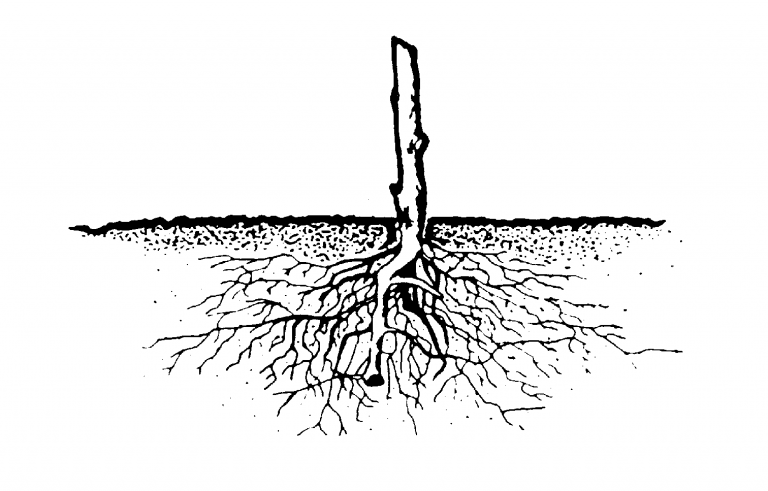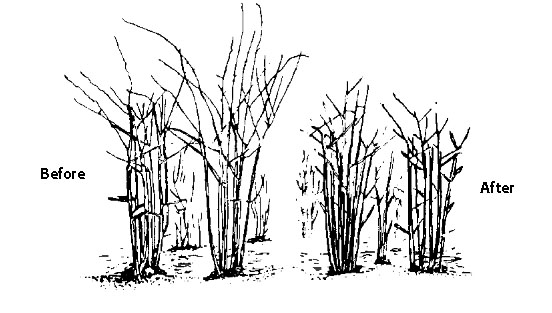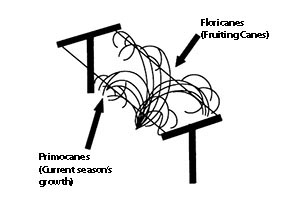Commercial Blackberry Production
Blackberries are among the easiest of all fruits to grow. Few fruits produce more dependably than blackberries. Properly maintained, irrigated plantings of good varieties may produce crops for 10 years or more. Blackberry fruit has a range of distinctive flavors that vary from sweet to tart. The fruit may be sold “U-pick”, fresh market, or frozen. It may also be sold to processors for freezing or canning. Well-established plants can produce up to 20,000 pounds per acre. All these features make blackberries an attractive crop for commercial fruit and vegetable growers.
Before deciding to grow blackberries, one should consider several points:
- site selection
- variety choice
- site preparation
- propagation & planting
- general care, including mulching, fertilizing, pruning,irrigation, training, and pest control
- harvesting
These points are discussed below.
Site Selection
Cultivated blackberries do best on sandy loam soils with organic matter. However, they will tolerate a wider range of soil types than most other fruits. Good soil drainage and 2.5-3 feet of unrestricted rooting area are necessary for best plant performance. A site with a slight north-facing slope is preferred. This helps prevent spring frost injury and protects plants from southwest winds in summer. Additional wind protection may be necessary, because succulent first year canes exposed to strong winds may be blown over and broken from the root system.
Variety Choice
Blackberries have an erect, semi-erect, or a trailing growth habit. Erect blackberries are recommended for commercial production because they require less labor than trellised brambles (blackberries, raspberries, etc.). Several good varieties of erect blackberries have been released by scientists in Arkansas. These varieties should be well adapted to Oklahoma conditions. Ripening dates may vary based on location. The varieties include:
Apache: ‘Apache’ is the latest ripening thornless Arkansas variety (~June 25). It is high yielding and has large berry size. It has excellent postharvest potential and is good for shipping. Flavor for ‘Apache’ is considered good (sweet), between ‘Navaho’ and ‘Arapaho.’ The chilling requirement for ‘Apache’ is about 800 hours, one of the higher totals among these varieties along with ‘Navaho’
Arapaho – ‘Arapaho’ is the earliest ripening thornless variety (~June 7). It yields lower than ‘Navaho,’ ‘Apache,’ or ‘Ouachita.’ Fruit storage and handling is good. ‘Arapaho’ has a sweet flavor. The chilling requirement for ‘Arapaho’ is around 500 hours.
Chickasaw – ‘Chickasaw’ ripens slightly later than several of the other thorny Arkansas varieties, about 2 or 3 days after ‘Shawnee’ (-June 11). It produces high yields, among the best of the Arkansas varieties, and has a very large berry. Flavor sweetness is near to that of ‘Shawnee’ and ‘Kiowa.’ The postharvest potential is not as good as the thornless varieties, but has been shipped in the United States and Mexico. It also has a moderate chilling requirement of 500-700 hours, which is equal to or slightly more than ‘Shawnee.’
Kiowa – ‘Kiowa’ ripens with ‘Chickasaw’ and about four days after ‘Shawnee’ (~June 12). ‘Kiowa’ is thorny, has large fruit size, up to 50% larger than ‘Shawnee’. It also has improved postharvest handling capability and quality over ‘Shawnee.’ The ripening season can be quite long for ‘Kiowa’ (6 weeks or more). It has a lower chilling requirement (200 hours), which is lower than ‘Shawnee’ and ‘Chickasaw’.
Natchez – ‘Natchez’ is an early thornless, semi-erect blackberry that ripens around the same time as ‘Arapaho’ (~June 3). It has large berries (8 to 9 grams), comparable to ‘Apache.’ Yields are comparable to ‘Ouachita’ and ‘Apache,’ and twice that of ‘Arapaho.’ Flavor is good, similar to ‘Arapaho.’ Fruit stores well, so shipping is a possibility. Chilling requirement is likely around 500 hours.
Navaho – an erect, thornless blackberry. The fruit are large and firm, and are less tart than other thornless varieties. They ripen late in the season (~June 20). Only about 65% of root cuttings produce plants, so they are more expensive than most thorned varieties. This variety is moderately resistant to anthracnose, and is known hardy to -14 F in Arkansas.
Ouachita–‘Ouachita’ ripens between ‘Arapaho’ and ‘Navaho’ and produces very high yields, among the highest for any Arkansas thornless variety (~June 12). Berry size is larger than ‘Arapaho’ and ‘Navaho,’ but not as large as ‘Apache.’ Postharvest handling is excellent, comparable to ‘Navaho.’ ‘Ouachita’ also has very erect canes. It may have a lower chilling requirement than other Arkansas thornless cultivars, possibly 200-300 hours.
Prime-Jan™ – It is thorny. The primocane crop of ‘Prime-JanTM begins to ripen in mid-July. Berry size and yield have been problematic in high heat areas, but in more moderate climates such as Oregon, size and yield have been exceptional. In Oregon, yields up to 15,000 lb/ac have been achieved and berry size up to 15 g on primocanes was measured in Fayetteville, Ark. Floricane berry size is about 5 g. ‘Prime-Jan’TM also has a low floricane chilling requirement, likely 100-300 hours, among the lowest for the Arkansas thorny varieties. Not currently recommended for commercial production in Oklahoma.
Prime-Jim™ – It is thorny also. As with ‘Prime-Jan’TM, ‘Prime-Jim’TM has problems in high heat areas, but does well in moderate climates. It ripens with ‘Prime-Jan’TM on primocanes. Berry size can be up to 10 g (in Fayetteville, Ark.) and yields can be extremely high, nearly 18,000 lb/ac observed in Oregon on primocanes. Floricane berry size is comparable to ‘Prime-Jan’TM. It is more erect, more vigorous, and has a smaller seed than ‘Prime-Jan’TM. The chilling requirement for ‘Prime-Jim’TM is likely similar to that of ‘Prime-Jan’TM. Not currently recommended for commercial production in Oklahoma.
Shawnee – an erect, thorned blackberry. The fruit are large and of medium firmness, ripening with other thorny varieties (~June 8). The seeds are medium in size. This variety has more years of good yields than many varieties. Propagation by root cuttings is readily successful. This variety is moderately tolerant to anthracnose.
Site Preparation
A soil test is necessary to determine the need for fertilizer and lime (see Fact Sheet PSS-2207). The soil should be deeply cultivated, and organic matter such as compost should be incorporated into the rows. If the soil needs additional drainage, the row areas should be built up into raised beds. The beds should be from 6 to 10 inches high and 2 to 3 feet wide. Optimal pH for blackberries is around 6.5.
Propagation and Planting
Please note that all University of Arkansas-developed varieties mentioned here are patented, and may not be legally propagated for sale or for personal use. Non-patented blackberries may be propagated freely. Ask your plant supplier if you are in doubt.
Erect growing varieties are usually propagated with suckers or root cuttings, while the trailing varieties are propagated by tip layering. Both the time of propagation and the time of planting are influenced by the growth habit.
Erect Blackberries – Most nurseries produce plants from root cuttings. The root cuttings, 2 to 3 inches long and 1/8 inch diameter or larger (about the size of a pencil), are planted in the early spring (March). The rows of cuttings should be from ½-1 inch deep, with cuttings 3 to 6 inches apart in the row. Plants will be ready for transplanting into the permanent row during the following winter.
Another method for increasing erect blackberries is from naturally occurring sucker plants. One year old suckers are dug from established rows and set into new permanent rows (Figure 1). More sucker plants can be produced by tilling near existing plants, which breaks the roots and results in a generation of new plants from these “cuttings”.
Planting may be done at any time during the dormant season, but most planting is done during February or early March. Space plants 3 to 4 feet apart in rows that are 6 to 9 feet apart. Plants should be set at the same depth they grew in the nursery row. Unless rain is likely, water the newly set plants. Actively growing plants should be planted only after the chance of frost has passed.

Figure 1. One year old plant.
Trailing Blackberries – usually produce suckers or develop from cuttings. An easy, successful method of propagation is by means of tip layers. To tip layer blackberries, place the tip end of the cane into the soil about 2 inches deep and cover it with soil. This should be done in September or October. Roots will develop during the late fall and winter. Dig the rooted tips during February or early March. Cut the tips from the original canes, leaving a 3 to 4 inch section of the cane attached to it. Once established, one plant may produce from 10 to 20 tip layered plants each year without seriously affecting its fruit production. Space the new plants the same as for erect blackberries.
General Care
The crowns and root systems of blackberries live for many years. New canes arise from the crown each year and live for only two years. In the first growing season after planting, erect blackberry plants often produce prostrate to semi-erect canes. Erect canes will be produced in subsequent years. During the first year, the canes grow to their full height (“primocane”). The second season, these canes bear fruit and die (“floricane”). Primocane-fruiting varieties have been developed, but are not currently recommended for commercial production in Oklahoma. Unlike most blackberries, these plants will flower and fruit on first year growth.
- Mulching–Although mulching of blackberries is not required, it will help control weeds, conserve
soil moisture, and prevent cold injury to crowns. Mulching also promotes growth of
the extensive fibrous blackberry root system. Blackberries can be mulched with about
4 inches of organic material such as pine bark or wheat straw.
- Mulch should be replenished each fall after the first killing frost. Trailing blackberry varieties and erect varieties in their first year of growth may also be protected in this way. Allow the canes to remain on the ground, and cover them with some grass or straw mulch four to six inches deep. Let this temporary mulch remain until buds on the canes begin growth in late winter or early spring. Then remove it and put the canes on a trellis, if needed, as described in section d.
- Fertilizing – Very little commercial fertilizer is needed during the first year of blackberry establishment. In subsequent years, apply fertilizer to the blackberry plants at bloom time to stimulate plant growth, increase berry size, and boost total production. A second application of fertilizer should be made following fruit harvest to stimulate vigorous cane growth for next season’s production. After the first year, use about a total of about 10 pounds of a complete fertilizer such as 10-20-10 or 5 pounds of ammonium nitrate per 100 feet of row. Apply ½ of the fertilizer at bloom time, and ½ soon after fruit harvest.
- Pruning–First-year plants are allowed to produce as much growth as possible without pruning
or training to a trellis. Established plants grow new canes while the old canes are
fruiting. During the summer, prune off the last few inches of new canes, leaving them
3 to 3.5 feet tall. This is called “tipping.” Tipping forces the cane to develop lateral
shoots from buds near the top portion of the cane. Fruit produced the following year
from pruned canes will be at a convenient height for harvest. The fruits will be larger,
cleaner, and of better quality than if canes are not pruned, because most of the fruit
will be farther from the soil.
- While tipping the new canes, cut off old canes that have finished fruiting. Make the pruning cuts near the crown of the plant, and remove the old canes from the field. This will decrease the likelihood of disease problems in the blackberry plants later. It will also help control insects such as red-necked cane borers which overwinter inside canes.
- New canes that have produced lateral branches after summer pruning should be pruned again in late winter (February or early March) to simplify harvesting and increase berry size. Shorten lateral branches to about 12 to 15 inches in length. Some new canes may need to be completely removed during the winter so that fruit harvest will be easier the next year. This thinning will also increase air circulation, discouraging disease growth. Leave 3 to 5 canes per linear foot of row on erect blackberries (Figure 2). Leave 8 to 15 canes of 4 to 8 feet in length on trailing varieties.
- If there are dead canes that fruited but were not removed during the previous summer, these may be removed at this time. If machine harvest is a possibility, a vase-shaped plant is highly desirable. Removal of canes that make the plant too wide at the bottom will be necessary to facilitate the proper operation of the machine.
- Primocane-fruiting blackberries can be pruned differently depending on whether one
desires one crop or two crops per year. If one primocane crop is all that is wanted,
then after harvest all canes can be mowed to the ground. If two crops are preferred,
then after primocane harvest, tip canes back down past where fruiting occurred. The
remainder of the cane will become the floricane crop for the following year. All dead
canes should be removed.

Figure 2. Pruning erect canes.
- Training trailing varieties – Newer, erect blackberries may not require trellising. However, a trellis can aid
in the ease of harvest. There are several methods of trellising blackberries. Among
the most popular are the double curtain, or “T” trellis, and the 2-wire vertical trellis
(Figures 3 and 4).
- The double curtain trellis is made using posts with cross-members which form a “T.” The “T” post is about 3 to 4 feet long and about 5 feet above the ground. One wire is placed on the posts about half-way up the trellis. Two other wires are located on the crossbar, one on each side. The blackberries are trained up the trellis, with floricanes tied to one side of the “T” and primocanes to the other side. This trellis simplifies hand harvest because only one side of the trellis is picked each year. After the growing season, the dead canes are removed from the trellis, and the living canes are pruned as described for upright blackberries. This trellis is fairly expensive to build compared to the 2-wire vertical trellis.
- The 2-wire vertical trellis, also known as the 2-wire cordon, consists of posts with 1 wire half-way up the posts and another near the top of the posts (about 5 feet off the ground). The floricanes are trained to the top wire before they flower, while the new canes are allowed to trail on the ground or are tied to the lower wire. This system makes hand harvest easier by putting the fruit on top of the trellis rather than among new growth. It also allows for winter protection of canes by leaving them on the ground and covering them with mulch. However, the disadvantages of this trellis will become obvious as the new canes spread out and entangle picker’s feet.
- As mechanical blackberry harvesters continue to be developed, various trellises are
designed to work with them. If you intend to harvest trellised blackberries by machine,
use a system which is designed to work with the machine.

Figure 3. T-trellis for brambles. Floricanes are tied to one wire of the T, while primocanes are trained to the other wire.
Figure 4. Two-wire trellis for brambles.
- Irrigation – Summer watering is necessary for good plant establishment and to produce more top
growth for fruit production the following year. Drought severely decreases production
and berry quality, so irrigation during the fruit development and maturation period
is very important when rain fall is lacking.
- Water the blackberries whenever the soil under the mulch feels dry, or if plants appear to be wilting. Apply enough water to wet the soil to a depth of about six to ten inches without soaking the ground. Excess watering can cause the roots of the blackberries to die. Tensiometers or other water measuring devices may also be used to help with irrigation scheduling (see Fact Sheet BAE-1502).
- Pest Control–Spraying for insect, disease, and weed control may be necessary. See Current Report CR-6221 for more information. Help with identifying pests is available from your county extension educator.
- Harvesting–Since the excellent flavor of blackberries is associated with full maturity, they
should be picked at the correct stage of development. As blackberry fruit mature,
they enlarge, develop a deeper blue-black color, and soften. When the berries appear
ripe, a “taste test” is the best indicator of when to pick. Of course, market considerations
must also be taken into account. Some blackberries fall apart if they are allowed
to ripen too much before they are picked.
- Harvest fruit during the cooler part of the day and plan to refrigerate the berries soon after harvest. Berries will usually remain in good condition for several days. Berries exposed to high temperatures after picking often decay rapidly. Some blackberries are soft at harvest, so they must be handled gently and stacked shallowly to avoid fruit damage. Other varieties are firmer when they are ripe. Overly ripe fruit are too soft to handle commercially, so care must be taken to pick the fruit at the right stage of ripeness. Mechanical harvesters are available, but are very expensive at this time and may not be gentle enough for some varieties.
Additional Fact Sheets Available
BAE-1502 Irrigation Water Measurement
BAE-1511 Drip (trickle) Irrigation Systems
PSS-2207 How to Get a Good Soil Sample
PSS-2750 Guide to Effective Weed Control
HLA-6005 Mulching Garden Soils
CR-6221 Grape, Blackberry and Strawberry Insect and Disease Control
HLA-6229 Pollination Requirements for fruits and Nuts
Becky Carroll
Extension Assistant
